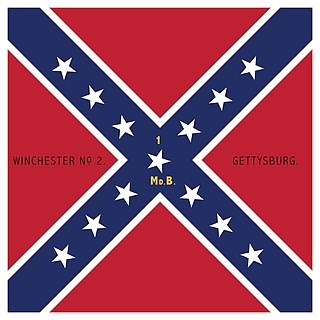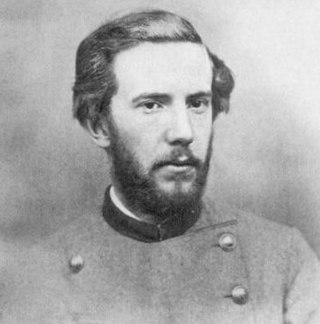
Alfred Thomas Archimedes Torbert was a career United States Army officer, a Union Army General commanding both infantry and cavalry forces in the American Civil War, and a U.S. diplomat.

The Battle of Trevilian Station was fought on June 11–12, 1864, in Union Lt. Gen. Ulysses S. Grant's Overland Campaign against Confederate Gen. Robert E. Lee's Army of Northern Virginia. Union cavalry under Maj. Gen. Philip Sheridan fought against Confederate cavalry under Maj. Gens. Wade Hampton and Fitzhugh Lee in the bloodiest and largest all-cavalry battle of the war.

The U.S. state of West Virginia was formed out of western Virginia and added to the Union as a direct result of the American Civil War, in which it became the only modern state to have declared its independence from the Confederacy. In the summer of 1861, Union troops, which included a number of newly formed Western Virginia regiments, under General George McClellan, drove off Confederate troops under General Robert E. Lee. This essentially freed Unionists in the northwestern counties of Virginia to form a functioning government of their own as a result of the Wheeling Convention. Before the admission of West Virginia as a state, the government in Wheeling formally claimed jurisdiction over all of Virginia, although from its creation it was firmly committed to the formation of a separate state.

Major-General Joseph Robert Davis was an American politician and lawyer who served as the commanding general of the Mississippi National Guard from 1888 to 1895. During the American Civil War, he served as aide-de-camp to the President of the Confederate States and commanded a brigade in the Army of Northern Virginia. He is best known for his role at Gettysburg. A member of the Democratic Party, he represented Madison and Scott counties in the Mississippi Senate from 1860 to 1861.

The city of Winchester, Virginia, and the surrounding area, were the site of numerous battles during the American Civil War, as contending armies strove to control the lower Shenandoah Valley. Winchester changed hands more often than any other Confederate city.
The American Civil War bibliography comprises books that deal in large part with the American Civil War. There are over 60,000 books on the war, with more appearing each month. Authors James Lincoln Collier and Christopher Collier stated in 2012, "No event in American history has been so thoroughly studied, not merely by historians, but by tens of thousands of other Americans who have made the war their hobby. Perhaps a hundred thousand books have been published about the Civil War."
The 63rd Ohio Infantry Regiment was an infantry regiment which served in the Union Army during the American Civil War. It was a part of the Union forces in the Western Theater of operations.
Allen Sherrod Cutts was a Mexican-American War veteran who served as a colonel of artillery in the American Civil War, fighting for the Confederacy.

The 2nd Virginia Cavalry Regiment was a cavalry regiment raised in Virginia for service in the Confederate States Army during the American Civil War. It fought mostly with the Army of Northern Virginia.
The 61st Ohio Infantry Regiment was an infantry regiment in the Union Army during the American Civil War.

The 62nd Ohio Infantry Regiment was an infantry regiment in the Union Army during the American Civil War.

The 1st Maryland Infantry, CSA was a regiment of the Confederate army, formed shortly after the commencement of the American Civil War in April 1861. The unit was made up of volunteers from Maryland who, despite their home state remaining in the Union during the war, chose instead to fight for the Confederacy. The regiment saw action at the First Battle of Manassas, in the Shenandoah Valley Campaign, and in the Peninsular Campaign. It was mustered out of service in August 1862, its initial term of duty having expired. Many of its members, unable or unwilling to return to Union-occupied Maryland, went on to join a new regiment, the 2nd Maryland Infantry, CSA, which was formed in its place.

The 2nd Maryland Infantry, CSA, was a Confederate infantry regiment made up of volunteers from Maryland who, despite their home state remaining loyal to the Union during the American Civil War, chose instead to fight for the Confederacy. The regiment was largely made up of volunteers from the 1st Maryland Infantry, CSA, which was disbanded in August 1862, its initial term of duty having expired. They saw action at many of the fiercest battles of the Civil War, taking part in the brutal fighting at Culp's Hill at the Battle of Gettysburg. The unit suffered such severe casualties during the war that, by the time of General Robert E. Lee's surrender at Appomattox Court House on April 9, 1865, only around forty men remained.
The following list is a bibliography of American Civil War Confederate military unit histories and are generally available through inter-library loan. More details on each book are available at WorldCat. For an overall national view, see Bibliography of the American Civil War. For histories of the Union, see Bibliography of American Civil War Union military unit histories. For a guide to web sources see: Carter, Alice E.; Jensen, Richard. The Civil War on the Web: A Guide to the Very Best Sites—Completely Revised and Updated (2003).

Conrad Wise Chapman was an American painter who served in the Confederate States Army from 1861 to 1865.
The 16th Connecticut Infantry Regiment was an infantry regiment that served in the Union Army during the American Civil War.
The American Civil War bibliography comprises books that deal in large part with the American Civil War. There are over 60,000 books on the war, with more appearing each month. There is no complete bibliography to the war; the largest guide to books is over 40 years old and lists over 6,000 titles.
The Bog Wallow Ambush was a small unit action during the American Civil War that took place between Confederate forces under Captain J. Fred. Waring and Union forces under Colonel George W. Taylor on December 4, 1861, in Fairfax County, Virginia, as part of Maj. Gen. George B. McClellan's operations in northern Virginia. The Union force set up an ambush for the Confederate force on the Braddock Road. The action resulted in a Union victory.
The 12th Pennsylvania Cavalry was a cavalry regiment that served in the Union Army during the American Civil War.










